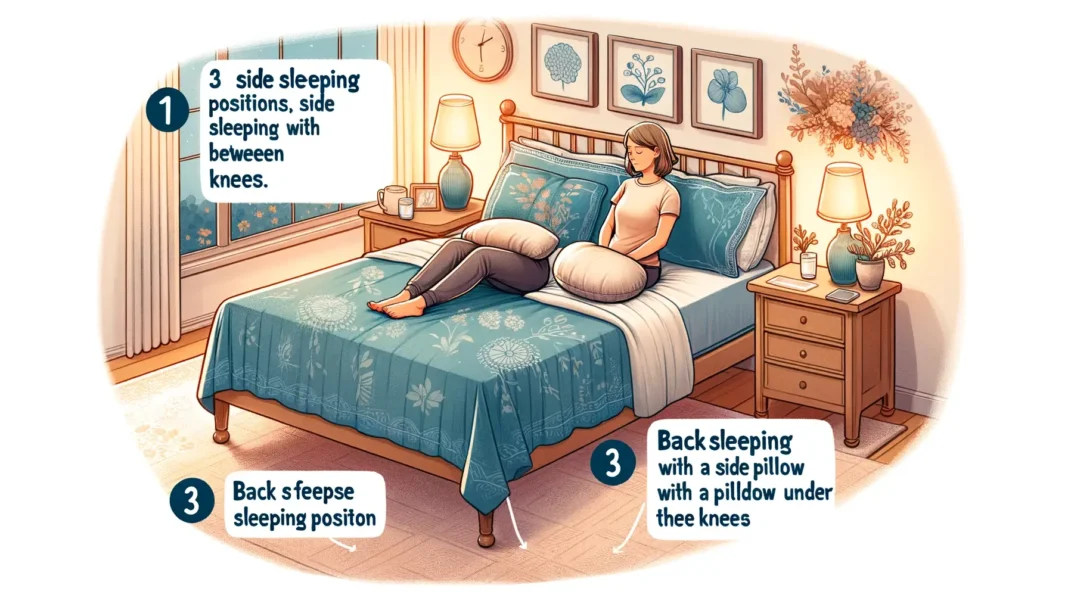A prolapsed bladder, or cystocele, occurs when the bladder sags into the vagina due to weakening of the pelvic floor muscles. This condition can cause discomfort and urinary issues, affecting a woman’s quality of life and sleep. Finding a comfortable sleeping position is crucial for those with a prolapsed bladder, as it can alleviate symptoms and promote a better night’s rest. In this post, we’ll explore the best sleeping positions for managing a prolapsed bladder and offer tips to enhance sleep quality.
Understanding Prolapsed Bladder
Before diving into sleeping positions, it’s essential to understand what a prolapsed bladder entails. This condition often results from childbirth, aging, or heavy lifting, leading to pelvic floor muscle strain. Symptoms may include a feeling of heaviness or fullness in the pelvis, discomfort or pain in the vagina, bladder, or lower back, and urinary problems like incontinence or frequent urination.
3 Best Sleeping Positions for Prolapsed Bladder
1. Side Sleeping with a Pillow Between the Knees

Sleeping on your side with a pillow between your knees is one of the most recommended positions for individuals with a prolapsed bladder. This position helps align the spine, hips, and pelvis, reducing pressure on the bladder. The pillow between the knees stabilizes the pelvis and reduces strain on the pelvic floor muscles, relieving symptoms.
2. Fetal Sleeping Position

Adopting a fetal position, with knees gently tucked towards the chest, can also alleviate discomfort. This position relaxes the pelvic floor muscles and minimizes pressure on the bladder. Ensure your posture is tight enough to prevent restricting breathing or causing discomfort.
3. Back Sleeping with a Pillow Under the Knees

If you prefer sleeping on your back, placing a pillow under your knees can help maintain the natural curve of your spine and reduce pelvic floor muscle tension. This position distributes weight evenly and minimizes pressure on the bladder, offering symptomatic relief. Avoid flat back sleeping without support, as it can increase pressure on the pelvic organs.
Tips for Enhancing Sleep Quality
- Maintain a Healthy Weight: Excess body weight can increase pressure on the pelvic floor muscles, exacerbating symptoms. Maintaining a healthy weight through diet and exercise can reduce symptoms and improve sleep quality.
- Pelvic Floor Exercises: Regular pelvic floor exercises (Kegels) can strengthen the pelvic floor muscles, providing better support for the bladder and improving symptoms.
- Limit Fluid Intake Before Bed: Reducing fluid intake before bedtime can minimize nighttime urination, leading to fewer disruptions and a better night’s sleep.
- Avoid Caffeine and Alcohol: Both can irritate the bladder and increase the urgency and frequency of urination. Limiting intake, especially in the evening, can improve sleep quality.
Conclusion
Living with a prolapsed bladder can be challenging, but finding a comfortable sleeping position can significantly improve your quality of sleep and overall well-being. Experiment with the positions mentioned above to find what works best for you, and consider incorporating lifestyle changes and exercises that strengthen the pelvic floor.
If your symptoms persist or worsen, consulting with a healthcare provider is crucial to explore further treatment options. With the right approach, restful nights and relief from prolapsed bladder symptoms are within reach.
FAQ:
What is the best way to sleep with a prolapsed bladder?
The best way to sleep with a prolapsed bladder is on your side with a pillow between your legs. This position can alleviate pressure on the pelvic floor and may help reduce discomfort associated with a prolapsed bladder. Ensuring a comfortable, supportive mattress and using additional pillows can also help.
What is the best position to sleep in for your bladder?
For overall bladder health, sleeping on your side or back is generally recommended. These positions help reduce pressure on the bladder. Avoiding excessive fluid intake before bedtime can also prevent nighttime urination urges, ensuring better sleep quality.
Why is prolapse worse at night?
Prolapse symptoms may feel worse at night due to fluid accumulation in the pelvic area throughout the day, especially in the legs, which can increase pressure on the pelvic floor when lying down. The relaxation of pelvic floor muscles during sleep can also make the feelings of heaviness or discomfort more noticeable.
Does a bladder prolapse go away when you lie down?
While lying down can temporarily alleviate the pressure on the pelvic floor and may reduce symptoms of bladder prolapse, it does not make the prolapse go away. The relief is often temporary, with symptoms potentially resuming upon standing or with physical activity.
Why is prolapse worse some days?
Prolapse symptoms can vary in severity daily due to several factors, including physical activity, stress levels, hormonal changes, and overall body fluid levels. Symptoms may worsen on days with more physical strain or activities that increase intra-abdominal pressure (such as lifting heavy objects). Additionally, hormone fluctuations throughout menstrual cycles can affect muscle tone and pelvic floor strength, potentially exacerbating prolapse symptoms. Increased fluid retention on certain days can also contribute to feeling more symptomatic.

